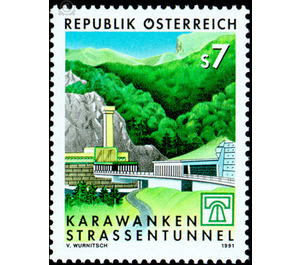opening - Austria / II. Republic of Austria 1991 - 7 Shilling
Theme: Architecture
| Country | Austria / II. Republic of Austria |
| Issue Date | 1991 |
| Face Value | 7.00 |
| Color | green blue |
| Printing Type | Photogravure |
| Stamp Type | Commemorative |
| Item Type | Stamp |
| Chronological Issue Number | 1376 |
| Chronological Chapter | OOS-OE2 |
| SID | 380774 |
| In 60 Wishlists | |
The Karawanken are part of the southern Limestone Alps and natural border between Slovenia and Carinthia. Already in pre-Christian times there were active long-distance trade relations in this area. The Karawankenmassiv presented an almost insurmountable obstacle. The first transport route was a mule track built by the Romans over the Loibl. The decisive step in the expansion of the connection was made on August 25, 1728, when Emperor Karl VI, father of Empress Maria Theresa, opened the extended Loiblstraße. As this street no longer met the requirements of modern trade and travel requirements, construction began on the 8016 m long caravan railway tunnel, which opened on 30 September 1909. The age of the automobile and the associated increase in traffic led to the construction of the Karawankenstraßentunnels, the completion of which ensures the direct connection from the north to the south and southeast of Europe.


